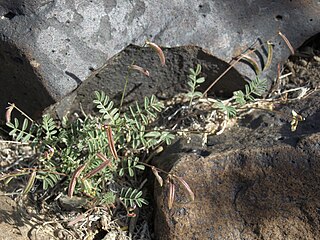
Astragalus acutirostris is a species of milkvetch known by the common name sharpkeel milkvetch. It is native to the Mojave Desert and surroundings of California, Nevada, and Arizona, where it grows in dry, sandy, gravelly areas.

Astragalus andersonii is a species of milkvetch known by the common name Anderson's milkvetch. It is native to eastern California and western Nevada, where it is found in the plateaus at the foot of the Sierra Nevada, including the Modoc Plateau. It was named after Charles Lewis Anderson by Asa Gray.

Astragalus austiniae is a species of milkvetch known by the common name Austin's milkvetch. It is native to the Sierra Nevada of California and Nevada in the vicinity of Lake Tahoe. It is a plant of the alpine climate of the high mountains, where it tolerates exposed areas.

Astragalus bolanderi is a species of milkvetch known by the common name Bolander's milkvetch. It is native to western Nevada and parts of the Sierra Nevada in California. It grows in dry, rocky habitat on mountain and plateau.
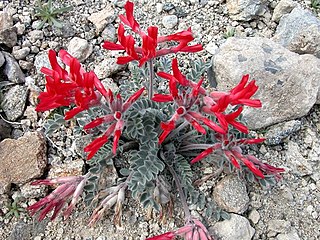
Astragalus coccineus is a species of milkvetch known by the common name scarlet locoweed or scarlet milkvetch. It is native to the deserts, scrub, and chaparral of the Southwestern United States in Arizona, California, and Nevada, and in northwestern Mexico.
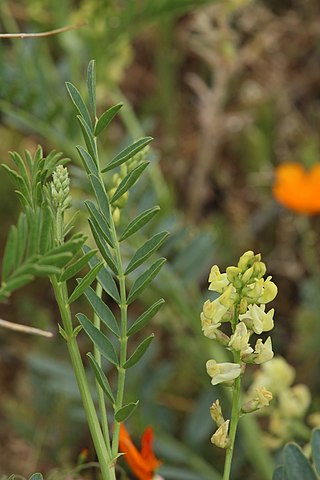
Astragalus douglasii is a species of milkvetch known by the common name Douglas's milkvetch. It is native to California and Baja California, where it can be found in many types of desert, valley, chaparral and woodlands, and montane habitats, usually below 8,000 feet (2,400 m) elevation.
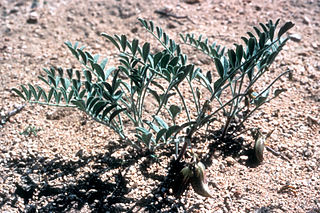
Astragalus ertterae is a rare species of milkvetch known by the common name Walker Pass milkvetch. It is endemic to California, where it is known from only three occurrences near Walker Pass in the Sierra Nevada. It is endangered by trampling, trail use, and also grazing.
Astragalus funereus is an uncommon species of milkvetch known by the common names Funeral Mountain milkvetch and black milkvetch.

Astragalus gambelianus is a species of milkvetch known by the common name Gambel's dwarf milkvetch. It is native to California, with its distribution extending into Oregon to the north and Baja California to the south.
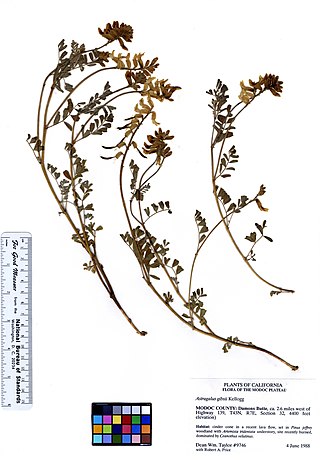
Astragalus gibbsii is a species of milkvetch known by the common name Gibbs's milkvetch. It is native to eastern California, the north-central Sierra Nevada, and western Nevada, where it grows in the pine forest habitat of the mountains and the sagebrush of the plateaus.

Astragalus kentrophyta is a species of milkvetch known by the common name spiny milkvetch. It is native to western North America from central to west Canada, to California, to New Mexico. It grows in rocky mountainous areas, such as the Sierra Nevada, and on plateaus.

Astragalus layneae is a species of milkvetch known by the common name widow's milkvetch. It is native to the Mojave Desert and surrounding mountain ridges in California and Nevada.
Astragalus obscurus is a species of milkvetch known by the common name arcane milkvetch. It is native to the northwestern United States in Idaho and Oregon and northern parts of Nevada and California. It is a plant of rocky areas in mountains and Great Basin plateaus. This is a small, mat-forming perennial herb with tufts of hairy stems approaching a maximum length of 15 centimeters. The leaves are up to 10 centimeters long and made up of thick oval-shaped leaflets. The inflorescence is a dense cluster of 5 to 15 off-white to faintly lilac-tinted flowers, each less than a centimeter long. The fruit is a narrow, leathery legume pod held upright in the infructescence. It may reach 2.5 centimeters in length and usually has two chambers inside.

Astragalus oocarpus is a rare species of milkvetch known by the common names San Diego milkvetch and Descanso milkvetch.

Astragalus oxyphysus is a species of milkvetch known by the common name Diablo milkvetch. It is endemic to central California, where it grows in dry grassland and scrub habitat in the Central Valley and the adjacent Inner Coast Ranges and Sierra Nevada foothills.
Astragalus pauperculus is an uncommon species of milkvetch known by the common name depauperate milkvetch. It is endemic to northern California, where it is known from the northern Sacramento Valley and the lowest reaches of the Cascade foothills adjacent. It grows in chaparral and vernally wet grassland habitat. This is a very small annual milkvetch which grows in a delicate mat with stems no longer than 10 cm (3.9 in). The leaves are a few centimeters long and are made up of small widely spaced leaflets. The inflorescence bears two to seven flowers which are purple, sometimes with paler colored edges on their petals. Each flower is generally less than 1 cm (0.39 in) long. The fruit is a crescent-shaped legume pod between 1 and 2 cm long.

Astragalus purshii is a species of milkvetch known by the common names woollypod milkvetch and Pursh's milkvetch.
Astragalus subvestitus is a species of milkvetch known by the common name Kern County milkvetch.

Astragalus webberi is a rare species of milkvetch known by the common name Webber's milkvetch. It is endemic to the coniferous forests in the Sierra Nevada, in Plumas County, eastern California.

Astragalus lentiginosus var. iodanthus, synonym Astragalus iodanthus, is a variety of Astragalus lentiginosus, a flowering plant in the legume family, Fabaceae. It is known by the common names Humboldt River milkvetch and violet milkvetch. It is native to the western United States, where its range includes California, Idaho, Nevada, Oregon, and Utah. It grows on hills and in valleys in barren sandy and volcanic soils in habitat such as sagebrush.

















